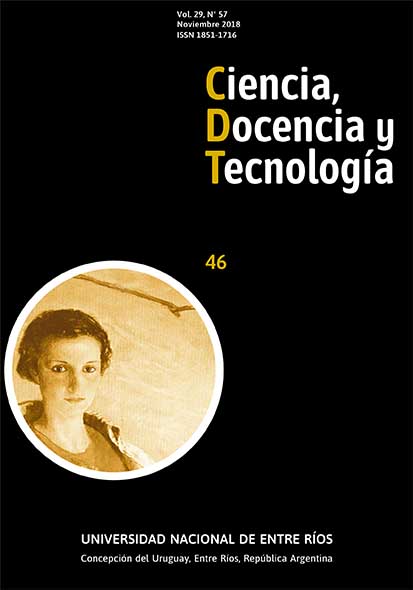Constructing utility meanings. Researchers, scientific knowledge and public problems
DOI:
https://doi.org/10.33255/2957/367Keywords:
scientific knowledge, academic groups, social utility of knowledge, public problemsAbstract
This paper addresses the issue of the social utility of scientific knowledge from a microsociological perspective. The article’s main objective is to analyze the processes of subjective assignment of senses of utility on scientific knowledge by researchers in the context of interactions with other non-academic actors interested in the use of this knowledge. Particular attention is paid to the temporal variations in the processes of construction of utility meanings as a result of actors’ reflexivity. The analysis is based on a case study carry out between 2009 and 2013 about an academic research group whose investigations are potentially useful for the local production of a vaccine for a reemerging disease in Argentina. As a result, the paper exposes the transformations in the practices of the research group resulting from their entry into a system of interactions with non-scientific actors as well as the limits of these changes.
Downloads
References
ALBORNOZ, M. y GORDON, A. (2011). “La política de ciencia y tecnología en Argentina desde la recuperación de la democracia (1983-2009)” en
ALBORNOZ, M. y SEBASTIÁN, J. (Eds.) Trayectorias de las políticas científicas y universitarias de Argentina y España. Madrid: CSIC.
ARBO, P. y BENNEWORTH, P. (2007). “Understanding the Regional Contribution of Higher Education Institutions: A Literature Review”. OECD Education Working Papers, No. 9, OECD Publishing
BEN DAVID, J. (1984). The Scientist's Role in Society: A Comparative Study. Chicago: University of Chicago Press.
BORUP, M.; BROWN, N.; KONRAD, K; VAN LENTE, H. (2006). “The Sociology of Expectations in Science and Technology” en Technology Analysis & Strategic Management, 18, (3/4): 285–298.
BOURDIEU, P. (2003). El oficio del científico. Ciencia de la ciencia y reflexividad. Barcelona: Anagrama.
BOURDIEU, P. (2007). El sentido práctico. Buenos Aires: Siglo XXI Editores.
BROWN, N. y MICHAEL, M. (2003). “A Sociology of Expectations: Retrospecting Prospects and Prospecting Retrospects” en Technology Analysis and Strategic Management, 15(1): 3-18.
BUSCHINI, J. y DI BELLO, M. (2015). “Emergencia de las políticas de vinculación entre el sector científico- académico y el sector productivo en la Argentina (1983-1990)”, en REDES Revista de Estudios Sociales de la Ciencia, 20, (39): 139-158.
CORVALÁN, D. (2017). “Des-aprendizaje y pérdida de capacidades locales. El calendario nacional de vacunación en Argentina”, en Ciencia, Docencia y Tecnología, 28, (54):01-37.
DOSI, G. (1999). “Some Notes in National Systems of Innovation and Production and their Implications for Economic Analysis”(35-48), en: ARCHIBUGI, D.; HOWELLS, J. y MICHIE, J. (Ed.), Innovation Policy in a Global Economy. Cambridge: Cambridge University Press.
EMIRBAYER, M. y MISCHE, A. (1998). “What Is Agency?” en The American Journal of Sociology, 103 (4):962-1023.
ETZKOWITZ, H., WEBSTER, A. y HEALEY, P. (eds.) (1998). Capitalizing Knowledge. New intersections of industry and academia. Albany: State University of New York Press.
ETZKOWITZ, H. y LEYDESDORFF, L (eds.) (1997). Universities and the Global Knowledge Economy The Triple Helix of University-Industry-Government. London: Pinter.
FINGERMANN, M.; FERNÁNDEZ, J.; SISTI, F.; y RODRÍGUEZ, M.E. y HOZBOR, D. (2003). “Bases epidemiológicas y moleculares para la reformulación de una vacuna del calendario nacional de vacunación”, en Boletín Fármacos, 6 (5): 55-59.
GIBBONS, M.; LIMOGES, C.; NOWOTNY, H.; SCHWARTZMAN, S.; SCOTT, P. y TROW, M. (1994). The New Production of Knowledge: The Dynamics of Science and Research in Contemporary Societies, London: Sage.
GIDDENS, A. (2006). La constitución de la sociedad. Bases para la teoría de la estructuración. Buenos Aires: Amorrortu.
GUILFOILE, P. (2010). Wooping Cough. New York: Chelsea House.
GODDARD, J. y CHATTERTON, P. (2003). “The Response of Universities to Regional Needs” (19-41) en BOEKEMA, F.; KUYPERS, E. y RUTTEN, R. (eds.), Economic Geography of Higher Education: Knowledge, Infrastructure and Learning Regions. Londres: Routledge.
GORDON, A. (2011). “Las políticas de ciencia, tecnología y educación superior en el período 2003-2010 en Argentina: continuidades y rupturas con el legado de los noventa” en Revista Sociedad, (29-30):169-194.
HOMMA, A. (1995). “Producción de vacuna DTP en las Américas” en Boletín de la Oficina Sanitaria Panamericana, 118 (1): 24-40.
HOMMA, A. DI FABIO, J. L. y de QUADROS, C. (1996). “Producción de vacunas para la prevención de las IRA: panorama regional” (143-163), en
BENGNIGNI, Y.; LÓPEZ ANTUÑANO, F.; SCHMUNIS, G y YUNES, J. Infecciones Respiratorias en Niños. Washington DC: Aiepi. Organización Panamericana de la Salud. Oficina Sanitaria Panamericana. Oficina Regional de la Organización Mundial de la Salud.
KREIMER, P. (2006). “¿Dependientes o integrados? La ciencia latinoamericana y la nueva división internacional del trabajo” en Nómadas (24):199-212.
LATOUR, B.(1992). Ciencia en acción. Barcelona: Labor.
LUNDVALL, B. (1992). National Systems of Innovation: Toward a Theory of Innovation and Interacting Learning. Londres: Pinter.
MEAD, G.H. (1932). The Philosophy of the Present. Chicago: University of Chicago Press.
MERTON, R. (1984). Ciencia, tecnología y sociedad en la Inglaterra del siglo XVII. Madrid: Alianza.
PIANCIOLA, L.; MAZZEO, M.; FLORES, D. y HOZBOR, D. (2010). “Optimización del procesamiento y la conservación de muestras clínicas destinadas al diagnóstico molecular de coqueluche” en Revista Argentina de Microbiología, (42):108-113.
PINHEIRO, R.; BENNEWORTH, P. y JONES, G. (eds.) (2012). Universities and Regional Development A critical assessment of tensions and Contradictions. Londres: Routledge.
RIVA POSSE, C. y MICELI, I (2005). “Evolución de la Coqueluche en Argentina a finales del sXX”, en Medicina, 65 (1): 7-16.
SATZ, M. L. y KORNBLIHTT, A. (1993). “La reacción en cadena de la polimerasa. El método y sus aplicaciones” en Ciencia Hoy, 4, (23).
SCHUTZ, A. (2003). El problema de la realidad social. Buenos Aires-Madrid: Amorrortu.
SLAUGHTER, S. y LESLIE, L. (1997). Academic Capitalism: Politics, Policies & the Entrepreneurial University. Baltimore: Johns Hopkins University Press.
SUASNÁBAR, C. (2011). “Políticas y reformas de la universidad argentina desde el retorno a la democracia: tendencias históricas de cambio y movimiento pendular de las políticas públicas” en Pensamiento Jurídico, (31): 87-103.
VACCAREZZA, L. y ZABALA, J. P. (2002). La construcción de la utilidad social de la ciencia. Estrategias de los investigadores académicos en biotecnología frente al mercado. Bernal: Universidad Nacional de Quilmes.
VACCAREZZA, L. (2004). “La utilidad de la investigación en ciencias
sociales: significado, uso e impacto”. Comunicación presentada al 5º Congreso de Estudios Sociales de la Ciencia y la Tecnología - ESOCITE. Ciudad de México.
VERSINO, M.; GUIDO, L. y DI BELLO, M. (2012). Universidades y Sociedades. Aproximaciones al análisis de la vinculación de la universidad argentina con los sectores productivos, Los Polvorines: UNGS-IEC-CONADU.
ZIMAN, J. (2000). Real Science. What it is and what it means. Cambridge: Cambridge University Press.
Downloads
Published
How to Cite
Issue
Section
License
The authors retain the copyright and grant the journal the right to be the first publication of the work, as well as licensing it under a Creative Commons Attribution License that allows others to share the work with an acknowledgment of the authorship of the work and publication initial in this magazine. All content is published under the Creative Commons 4.0 international license: Attribution-Non-Commercial-Share Alike.






